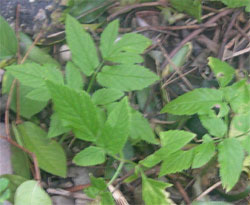Ground Elder (Aegopodium podagraria)
Posted by Fiona Nevile in General care | 0 comments The weather has been so mild that the lobelia in the pot outside the back door is still looking good. No flowers but loads of green lushness. I was quite chirpy about this until I realised that even my old enemy, the ubiquitous Ground Elder, is thriving.
The weather has been so mild that the lobelia in the pot outside the back door is still looking good. No flowers but loads of green lushness. I was quite chirpy about this until I realised that even my old enemy, the ubiquitous Ground Elder, is thriving.
Generally, the green parts of this nasty intruder die down during the winter and give me a breathing space from “observing ground elder” angst. I am aware that the roots thrive, whatever the weather. Triffid-like it encroaches silently but if I can’t see it I don’t mind it so much.
Rushing off this morning to accompany Jalopy for her service in Bury St Edmunds, I glanced down and noticed that the ground elder by the front door had reached the doorstep.
I have a constant battle with ground elder in the garden. We have a expanding patch of it in the pond garden and another swathe along the front of the house. I’ve run the gamut of ways to get rid of it from poisoning to smothering it with black plastic. I’ve tried digging it out, I filled three barrow loads of roots last summer but I missed a bit and it popped up again within a few weeks, green, frisky and fighting fit. If you leave the tiniest millimetre of root behind it will grow again.
Whilst Jalopy was being carefully examined in the Volve dealership I visited Waterstone’s in Bury and discovered an answer to The Ground Elder Problem. We can eat it. The Romans introduced it to Britain and cultivated it as as a salad crop. They were chomping on young elder leaves during their lunch breaks from building the long straight roads that run through this county.
I had spotted a tempting book on Amazon before Christmas and despite a desperate last minute email to Santa, it had clearly sold out in the North Pole branch of Waterstone’s, as it wasn’t in my stocking on Christmas morning. Santa must have believed that I’d benefit from a trip to a real bookshop as he slipped in a couple of book tokens instead. I stepped across Waterstone’s threshold with one book in mind, Wild Food by Roger Phillips. I finally found the book in the gardening section. It’s a winner. It’s informative with good photographs for identification purposes and an unexpected surprise: really good recipe contributions from great cooks like Jane Grigson and Katie Stewart.
Apparently the leaves are best when young and tender, before the plant has flowered. They can be added to salads and soup. They can also be cooked, like spinach, with a little butter. When I returned home I did a little more investigation on the internet and discovered that ground elder is attractive to bees, butterflies and birds. It was used medicinally in the Middle Ages and the flowering plant is still used in a homeopathic remedy to treat arthritis and rheumatism. So this spring we are going to try eating our old enemy. How’s that for revenge?
Leave a reply




